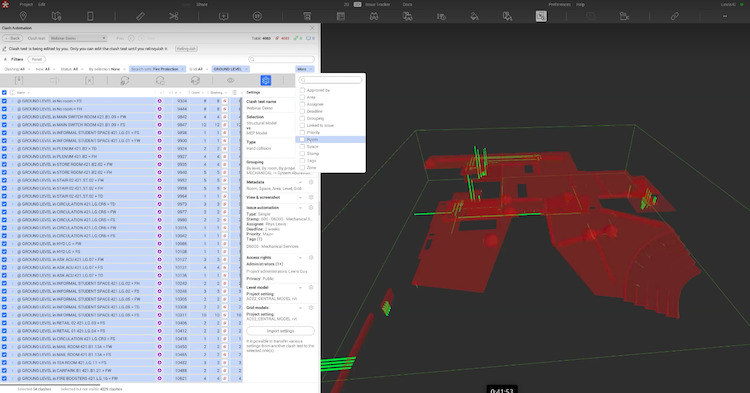
How long does it take to detect three million clashes on a large project? Just 45 minutes, according to Revizto in a presentation during the Digital Construction Summit.
Lewis Guy, VDC implementation manager at Revizto, demonstrated the newly launched Revizto+ platform with automated clash detection during the Summit session, Enhancing communication and collaboration with technology, sponsored by Revizto.
Guy said: “Generating the clash results is really quick. We’ve had Revizto+ on one of our biggest projects in the UK where we ran the search as everything against everything just as a test and we generated three million results in 45 minutes – it’s quick and can handle massive datasets.”
Revizto director Rhys Lewis revealed: “Clash automation is something we’ve been working on in the background for the last two years. Our development has listened to our clients’ feedback and what they’re asking for.”
Guy added: “We’re solving a problem the way BIM coordinators and managers want it to be solved. Revizto+ clash detection is built entirely around ‘search sets’, whether for models or specific data within the models (all the ducts or all the pipes for example). As Revizto is a collaborative platform, more than one person can run clash detections and review the results at the same time.”
The platform can search for five different clashes: hard, clearance, clearance with independent horizontal and vertical offsets, tolerance and tolerance with independent horizontal and vertical offsets. Detection searches can be grouped for further refining, and search results can be filtered.
Guy said: “What we’ve done with Revizto is make it the tool that can bring in all the files from all different locations, run the clash detection, you can share that information and then we have the ‘switch-back’ functionality that allows you to get in to your original models and fix the problems. It’s a connected process in one tool, not multiple tools. The clashes can be resolved a lot quicker because it’s easier for everyone to understand what’s going on.”
Kier is a recent convert to Revizto and is using the platform on the £64.3m Fitzalan High Council for Cardiff City Council. The school for 1,500 pupils includes 100 classrooms plus sports pitches and a swimming pool, and is scheduled for completion in 22/23 academic year.
Russell Baker, senior BIM manager at Kier Construction Western & Wales, said: “All the of the supply chain have embraced the implementation of Revizto.
“Our design coordination review started with clash detection. This was carried out in Navisworks, with the clashes then exported into Revizto. However, this process will probably change with Revizto+.”
Jonathan Walters, senior BIM coordinator at Kier Construction Western & Wales, added: “[Here’s] one of the benefits of Revizto’s plugins [from Archicad to Vectorworks, via Navisworks and Revit]: our steel manufacturer is using Tekla, and traditionally he’d send out his model via an IFC file to the architect; but the architect couldn’t pinpoint that IFC on to the correct location because they used different shared coordination systems; when we brought our Tekla model into Revizto, it overlaid in the correct location, so the architect is now reviewing the subcontractor’s models and drawings in Revizto instead of bringing in to his own Revit file.”
The Summit was run as a virtual even with nearly 1,000 industry professionals registering for the three webinars over two days. Partners for the event were the Chartered Institute of Building, Revizto and Trimble Viewpoint, Construction Manager and BIMplus.
Read the coverage of the rest of the Summit:
Comments
Comments are closed.















Great to see this tool evolving, thumbs up. But my lord….this is another example of a good tool being used badly!
Anybody comes to me with a clash report of three million, they would be off my team for sure because that isn’t useful to anyone and reinforces peoples perception that BIM = More work and cost. I would bet that the three million clashes here is 98% design in progress e.g. light pendants making contact with the ceiling, ductwork segments making contact with its corresponding duct segments, pipes and outlets clashing with walls that haven’t yet had the penetrations and builders work modelled and steelwork overlaps…all the stuff you should programme the tool to exclude until you are at the right stage.
I say this not to pick stitches, but to plead. I thought the days had gone where people ran clash reports like this because they hadn`t configured the tool to make it more intelligent. And it seems Revizto now has this feature so there is no excuse for such a painful and unhelpful report set.
Bottom line….Dont produce a clash report with more than 100 issues for your team! Even if you find 10k. Isolate the ones that affect the design or construction programme and only present those and then move onto the next priority. a slab, wall, steel or ducting intersection isn’t a clash during design development and focussing on those runs the risk of you missing the big problems.
The processes and collaboration methods developed, tested and provided for the industry to follow that could produce a clash avoidance collaborative model seems not to be followed or understood. The only clashes that should be found, in clash detecting the federated models are unresolved design conflicts. It would also seem from Johns comments that the origination software has a number of problems in as much as the objects being used to develop the models create clashes themselves and these cannot be removed by better clash avoidance procedures. This is actually creating costs in time spent resolving the millions of clashes. Has anybody done the math, 3M times say 5 mins to resolve each at £400 per day. That a lot of cost for no reason other than bad practice.